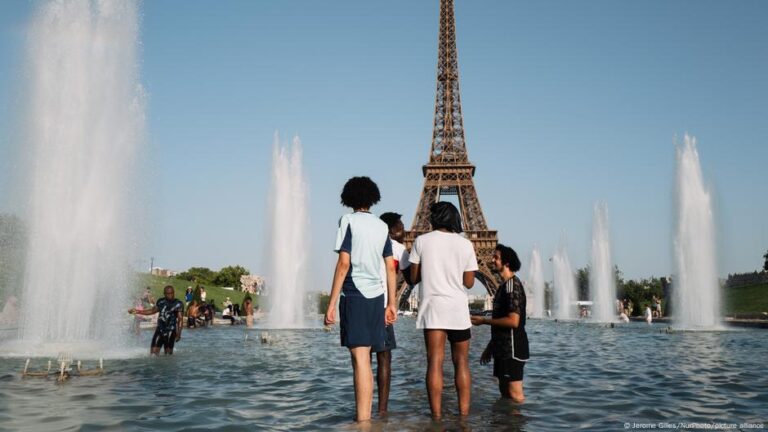There’s something about the shimmer, tinkle, and graceful arc of water in motion.
From ancient Minoan courts and Persian gardens to Roman aqueducts and modern plazas, fountains have been more than just ornamental — they’ve been sacred, social, symbolic, and of late, cooling-off spots in sweltering cities.
From the practical to the divine
With a history spanning almost five millennia, fountains first served practical needs.
Around 2,000 BCE on Minoan Crete, water from springs was channeled through terracotta pipes into stepped basins at palaces like Knossos and Zakros. These weren’t just for washing — they were integrated into religious sites for purifying rituals.
In ancient Egypt, fountains often featured lion’s head spouts, a motif passed down through Greco-Roman and Islamic traditions.
For instance, the Court of the Lions in the 14th‑century Moorish Alhambra palace in Granada Spain features a fountain consisting of 12 lion figures spouting water.
Associated with strength and divine guardianship, lions symbolized protective power. Thus, a lion in mid-roar made an ideal candidate for visually striking spouts, especially at palaces or grand entryways.
In traditional Islamic gardens, fountains and water features played a central role, reflecting the Quranic vision of Paradise and symbolized purity, life and divine beauty.
Influenced by the Moors of the Nasrid dynasty (residents of the aforementioned Alhambra) and the Persians of the Sasanian empire, these gardens were designed to evoke spiritual bliss and harmony by integrating, among others, fountains into their layout.
Symbolism and service
In Europe, the Renaissance and Baroque periods transformed fountains into vehicles of spectacle and political symbolism.
Leading the pack are Rome’s famed fountains: Bernini’s Fountain of the Four Rivers in Piazza Navona represents the four major rivers known during the Renaissance: the Nile (Africa), the Danube (Europe), the Ganges (Asia) and the Río de la Plata (Americas). Commissioned by Pope Innocent X and built in 1651, it symbolized the global reach of the Catholic Church and the Pope’s power.
Completed in 1762, the Trevi Fountain has since achieved pop icon status and is now an influencer magnet, partly due to the legend that a coin tossed into it would ensure a return to the Eternal City, likely influenced by the 1954 movie “Three Coins in the Fountain.”
In Ottoman Istanbul, public “cesme” or fountains were donated by wealthy families as acts of charity. Often bearing poetic inscriptions, these fountains offered water freely in a hot climate and were meeting spots for the city’s residents.
Modern spectacles
Fast forward to the 20th and 21st centuries, and some fountains have even become iconic “performers.” California-based WET Design created two such examples.
The Bellagio Fountains in Las Vegas, opened in 1998, feature more than 1,000 fountains swaying to music and enhanced by light. The display spans more than 300 meters (around 1,000 feet) with water soaring as high as 138 meters. This audiovisual spectacle reportedly utilizes water from an onsite well and not city water systems.
With 6,600 underwater lights that some claim can be seen from the International Space Station, the Dubai Fountain located on the Burj Khalifa Lake is reportedly the world’s largest performing fountain. Close to 275 meters wide and shooting water 150 meters high, its waters are choreographed to sway to Arabic classics or K-pop hits.
Wasteful or wise?
Critics have argued that fountains waste water, especially in drought-prone regions.
During drought conditions, some cities turn off their decorative fountains to preserve water resources, as was the case in Milan in 2022.
Facing this problem, modern designs often use recirculated water and solar-powered pumps.
Research has shown that fountains can have localized cooling effects — especially when they incorporate fine sprays or mist, which increase evaporative contact with air.
According to the European Climate-Adapt initiative (2024), “water spray from a fountain has an even greater cooling effect due to the large contact surface between water and air, which stimulates evaporation.” Similarly, Urban Green-Blue Grids states that “fountains and misting installations cool the air and skin by means of evaporation.”
Ancient currents, timeless purpose
Thus as Europe — the fastest-warming continent, according to the World Meteorological Organization — wilts under punishing heatwaves, cities have been adapting their existing water features to meet modern needs.
In Paris, the 19th-century Wallace fountains, scattered across the city and originally created for free drinking water, were retrofitted in 2021 with misting nozzles that spring into action during strong heat. Vienna has misting arches, interactive fountains and playful water zones for kids and adults looking to cool off. Berlin is expanding its network of touchless drinking fountains, combining hygiene and hydration.
In 2022, archaeologists restored a Roman imperial period fountain in Turkey’s ancient city of Kibyra using over 150 original marble fragments. Turkiye Today reported in April 2025, that the fountain built in 23 CE, “has begun flowing again” making Kibyra the second Turkish ancient city “to feature a restored and functioning Roman fountain.”
It has to be underscored though that fountains alone could not temper city temperatures; that would require a complete overhaul of how cities are planned.
Yet the fact that urbanites are often drawn to fountains in their living spaces — whether to immerse themselves in the cool water or quench their thirst at those offering potable water — show that fountains aren’t just relics of gilded eras. Their soothing relevance may see a renaissance as we are set to face a hotter future.
Edited by: Elizabeth Grenier


